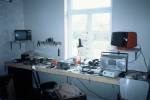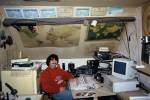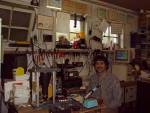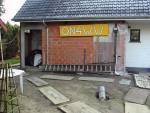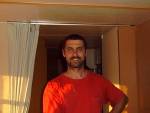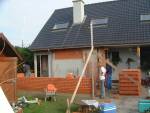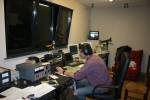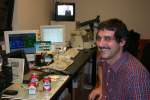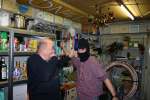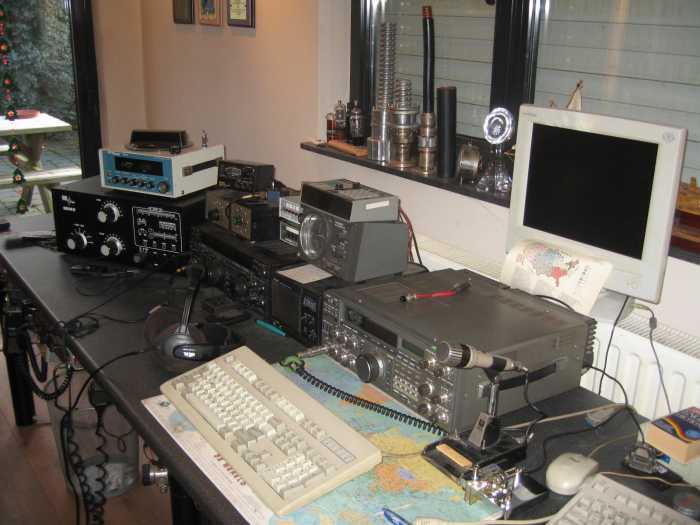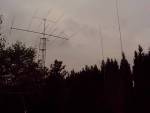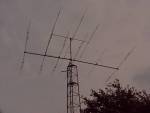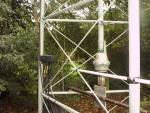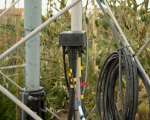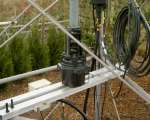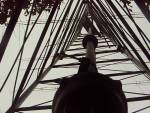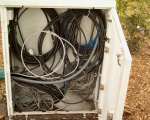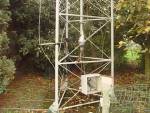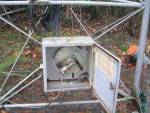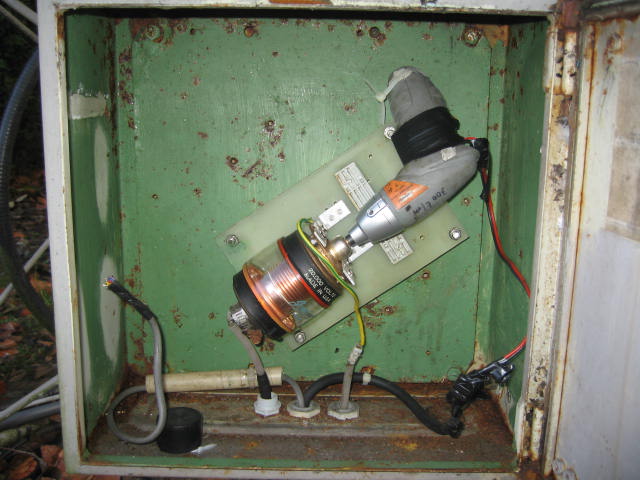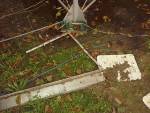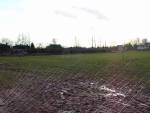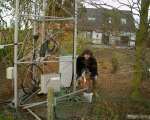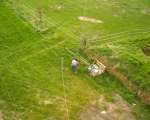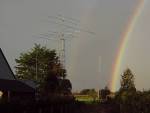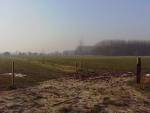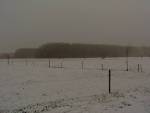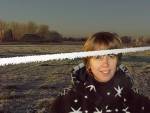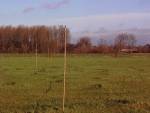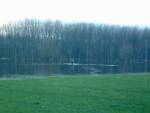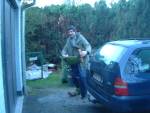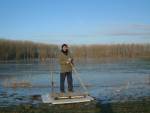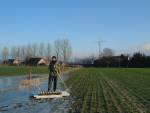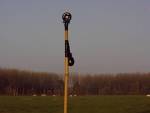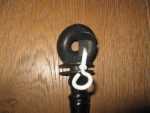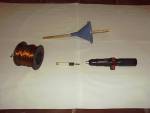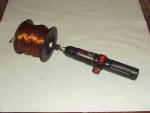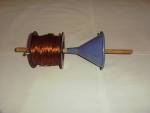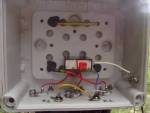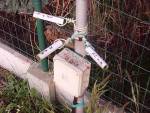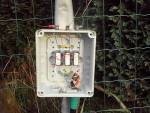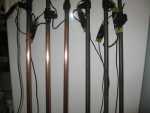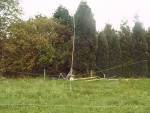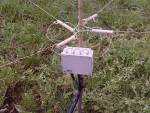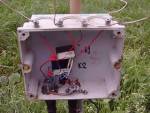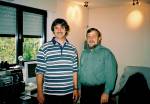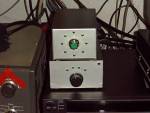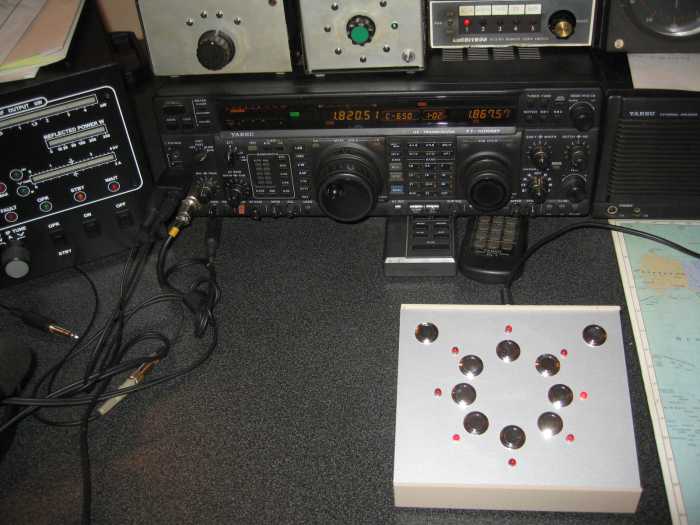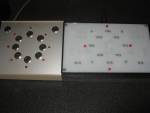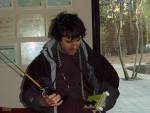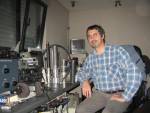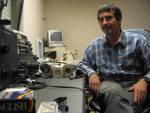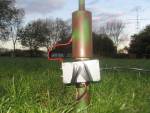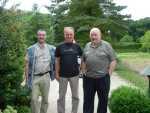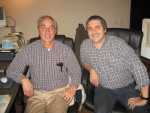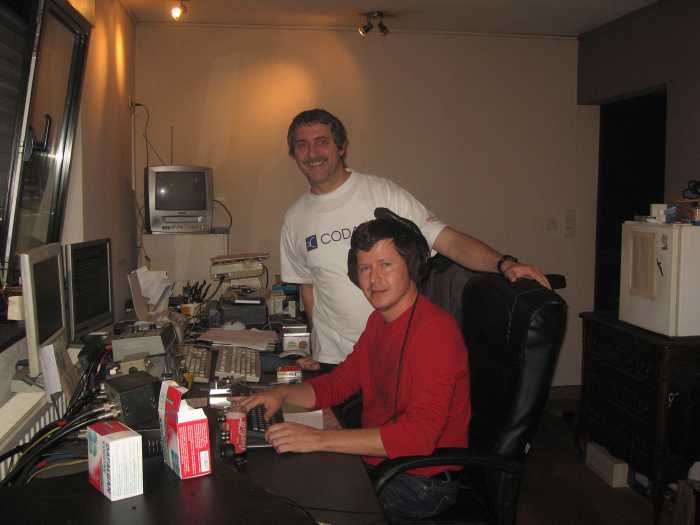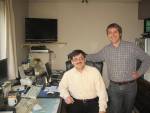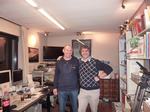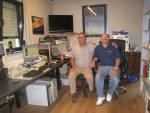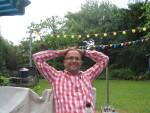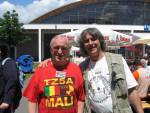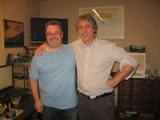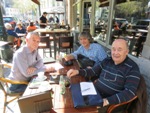Over the years, most hams undergo the discomfort of having to move their shack
to different places. A discomfort, because with the years the pile of stuff
to move, grows and grows.
It is not different with me, and I consider myself fortunate that I am now in
shack number four, which should be the final destination.
As for antenna installation, this is a continuing process, in search for the
optimum combination for successful communications.
I had to compromise, as the regulations in our country have become too severe
and intolerant for ease of erecting towers.
Nevertheless, although my antennas are technically too low in height, the ON4WW
station seems to be getting through the pileups with relative ease.
Topband has my main attention nowadays. Following links show my up to date
160m score, with call signs of stations first worked per DXCC
alphabetically, and Chronological
in Excel files.
The confirm field (CFM) shows N=not cfmd yet, Y=cfmd by that specific station
and (Y)=cfmd by another station from that country.
No surprise my brother in crime Peter ON6TT was my first ever DX topband QSO,
when he activated C30EMA in August 1990. Perhaps your call sign is on my list
? Thanks !
17 October 2005 : finished my WAS and WAZ by working KL7HBK on topband for my
#242 - tnx John !
The actual station (August 2022) comprises a Yaesu FT-1000MP, a 32 year young
KLM KT34-XA and a Cushcraft A3WS with 30m extension for the WARC bands.
For the low bands I use a quarter wave vertical for 40m, the twelve meter self-supporting
tower shunt-fed for 80m, and an Inverted-L for 160m.
In 2020 the 4-square project
was finished, which enabled access to 4-square antennas on the 40, 80 and 160m
bands.
I like QRP, I like QRPp. What a thrill to make contacts across the big pond
with less than 1 Watt on topband !
I like QRO. When it comes down to amplifiers, it is a good idea to buy an amp-with-support
on your own continent.
A testimony to this can be read on the OM
POWER Amplifiers Page (they've held my back for a long time, tnx guys!).
In my 30+ years of contesting, Mr. A.C. Murphy was so kind to pay me several
visits and he wrote something about his own
activities during the CQWWCW contest, edition 2005.
The photographs give a general as well as detailed overview of the station,
antennas and visitors.
Click on the photographs to see the full size pictures. Credit for some of the
photo's goes to ON5TN and DL2CC.
|
|
The first shack in 1988. Simple means don't necessarily give small results.
Ten thousand QSOs were made the first year. Yep, that's a Commodore C64.
And a Kenwood TS-430S radio |
|
|
The second shack, also inaugurated in 1988. Dad went under the roof when
son was born. Notice my first 286 PC, courtesy ON4AMI. The picture was taken
in 1990, an upgrade to a TS-940S radio was made |
|
|
The third shack. We moved houses in 1993, and dad was confined to the
garage. After eight years, and two years of waiting for a building permit,
there is hope for a final and decent shack |
|
|
Another view of the third shack. History now. Still can't find space to
put the car inside. In 1997 I bought an FT-1000MP from the VK0IR expedition.
Later on an amp (the LK-800 from Amp Supply) was added to the setup. Mind
you, my first 300 entities were worked barefoot (even though evil souls
will tell the contrary, ha!) |
|
|
Yes, right, I can't wait for this bl..dy permit to get here ! A 3 by 6m
shack all for myself, waw ! The canon coming out of the ground, is actually
for underground feedlines, which will enter directly in the shack |
|
|
This is the amount of hair I had before trying to get this shack building
permit, now two years ago |
|
|
See me now ! I pulled out most of my hair, how can one have to wait for
two years to get a building permit ! Life's too short for QRP, but also
for this nonsense |
|
|
Jabbadabadoooo....some concrete has been poured |
|
|
After two and a half years, the building permit came. This is how things
stood in January 2003 |
|
|
Getting there... |
|
|
Inside the work can start |
|
|
Starting to compose and assemble the bits and pieces of the new shack |
|
|
Cabling under the radio table. Good labeling from the start is important
(so dude, where is the labeling?) |
|
|
Final painting was done September 2004. Notice the two dualband vhf/uhf
antennas on the side walls, used for packet radio and local voice operation |
|
|
End 2003, the new shack is finished. The LK-800 amp has been replaced
by another amplifier, see the horror story on that one here
(note: as I learned that the ownership of this amp manufacturer will change
in the near future, I decided to leave out the company name) |
|
|
Celebrating the fourth shack, a couple of beers, notice the books ? Right,
DL2CC and ON4UN visiting... |
|
|
The masked man versus ON4UN in a flycatch fight |
|
|
31 December 2008. Luc ON5UK was successful in restoring my old TS-940S
radio (tnx buddy!). I decided to put the radio back into play, and here's
how the shack looks like nowadays. Notice the OM
Power amplifier, a trustworthy piece of equipment! |
|
|
Left to right : KLM KT34-XA with Cushcraft A3WS on top, 40m quarter wave
vertical, vhf/uhf antenna |
|
|
Close-up of KT34-XA and A3WS. March 2004, a 4 element 6m yagi has been
installed in between those antennas (courtesy Karel ON5TN, tnx!) |
|
|
The Ham IV rotor is mounted at the bottom of the tower for ease of service.
It will be replaced by a heavy duty rotor. On the left is the Ameritron
RCS-8V Remote Coax Switch, to which the five transmit antennas are connected |
|
|
Close-up of the RCS-8V. This remote coax switch is 14 years old, and guess
what, after all those years not only does it still work flawlesly, the sales
price is still the same, would you believe it !!! Way to go Ameritron. |
|
|
Somewhere in 2003 the Ham IV rotor was replaced by a Yaesu G-2800DXC |
|
|
Heavy steel pipes go from the rotor all the way to the top |
|
|
These cables come both from the shack, and from the field to the shack,
and pass through this cabinet near the tower. Thanks ON4MA for the new cabinet
! Need to sort it out a bit... |
|
|
The vertical shunt-feed wire for the 80m vertical, slopes towards the
series capacitor in the cabinet, here an air cap |
|
|
The 80m shunt-feed series capacitor is DC-motor driven and can be tuned
for low SWR across the band. The air cap has been replaced by a vacuum varicap
and a coaxial fixed cap in parallel |
|
|
The coaxial fixed cap has been replaced by high voltage caps |
|
|
This is the final setup, with a heavy duty vacuum varicap, which replaces
the previous one |
|
|
Oops, never say final. Here is the (probable) final setup, with the heavy
duty vacuum varicap, which is driven by a simple screw driver. Works like
a charm |
|
|
The base of the 160m inverted-L. Inside the cabinet is an LC matching
network. August 2005, this simple antenna yielded 241 countries so far.
May 2014, the total is 303 entities. You can find more info on this simple
and effective antenna right
here |
|
|
In the beginning , at the base of the tower chicken wires were used instead
of a layer of radial wires. Worked for me |
|
|
In 2004 we re-did the garden, and 44 radials are permanently underground.
In wintertime, another 40 radials are laid out on the Beverage field, as
can be seen on the picture. The chicken wires finally got company ! |
|
|
The 40 winter-radials rolled up in springtime |
|
|
A view down from the tower, I'm working on the 40m quarter wave vertical.
The vertical has been moved from the garden to the field |
|
|
40m vertical ready for sunset |
|
|
Base of the 40m vertical |
|
|
Close-up of the 40m vertical base. With one chicken wire and ground rod,
SWR was < 1.7:1
Adding five radials of 5m length each, brought SWR to 1.2:1 on the entire
band (7-7.2 MHz)
Low SWR doesn't mean good performance. I'm fortunate to have good local
ground conditions
|
|
|
It's seldom we get a nice sunset at this QTH, but this one will do |
|
|
And this is the nicest rainbow ever, doubled up by a faint second rainbow
touching the yagi's...wonders of nature |
|
|
In winter time, these fields were used to deploy eight Beverage antennas
of each about 170m length, spread every 45 degrees (until 2012).
These are the - almost indispensable - tools for successful topband operation.
Late 1997, John ON4UN made this freehand
drawing schematic tailor-made for my specific location. |
|
|
Snow in Belgium, doesn't happen too often anymore.
The Beverages in winter make for nice views in the early morning hours,
when the wires are covered with ice |
|
|
XYL Katrien inspects the icing on the Beverage wire. Great picture, and
her coat is compatible with the weather elements. The 0.8mm Beverage cupper
wires don't appreciate the icing, but only few have been overstretched due
to the weight and broke |
|
|
All Beverages are supported by 2m tall bamboo sticks. Going straight ahead
is the North Beverage, and to the left is the South Beverage |
|
|
Flooding end of December 2002 in Belgium. Half of the Beverage field is
covered with knee-deep water. Here I'm repairing the Northwest Beverage
which was lying partly in the water after a duck or goose flew into it |
|
|
Knee-deep water and inappropriate protection, makes for wet boots and
socks, and freezing cold feet ! |
|
|
Okay, let's try do things better. Mark junior quickly made this raft,
tested it the day before, it works great. The white spot in the background,
is the furthest away Beverage box, which I need to reach. This is the Southeast-South
Beverage box, it doesn't work. Probably the coax cable is damaged while
government officials cleared the stream of mud |
|
|
Oops, I got stranded. The water flood is frozen overnight, I need an ICEBREAKER
instead of a raft ! In the background is the tower with KT34-XA and A3WS |
|
|
Here is Katrien, testing the raft, somehow. When she married me, she told
people she knew 'she was marrying my radio as well'. Anno 2004, we've been
together for 24 years. Life is beautiful, so is she. Quite a woman, to put
up with me! |
|
|
Eye bolts (such as used on cattle farm land to hold the high voltage wires)
are easily attached to a bamboo stick and guide the Beverage wire. The lower
eye bolt is used when two Beverage wires cross each other |
|
|
In the 2008-2009 winter season, I added eye screws to the eye bolts, in
order for the Beverage not to jump out. That happened from time to time |
|
|
An easy system makes for quick Beverage deployment and take down |
|
|
The electrical screwdriver connected to the spool with the Beverage wire.
This setup is used when taking the Beverages down. Easy spooling makes for
a time of only just over an hour to take the eight Beverages down in a neat
way |
|
|
Deployment is even faster. For unwinding the Beverage, this simple hand
tool makes for a time of 35 minutes to installl the eight Beverage wires.
However, getting all bamboos in place takes a bit more time. It takes about
4 hours to install the whole system. |
|
|
Depicted is the first relay box near the tower, in which a split is made
towards the three Beverage relay boxes |
|
|
This is one of those relay boxes, with NW, W and SW directions. For ease
of removal during summertime, note the 'eye' connections attached to the
end of the wire. The Beverage wires also have such an eye, and both are
fastened with a small stainless steel bolt and nut |
|
|
Nothing much to it, simple component circuitry makes for long-life reliability
of the setup. This system has been used by ON4UN for many years, and now
at my station too |
|
|
Beverage termination ground rods with resistors at the top. The rods to
the right were in use for about 10 seasons. The ones to the left too, but
they have just been cleaned before the picture was taken. Necessary! During
the 2007-2008 winter season, I noticed my Bevs were not having much F/B
anymore. This was the reason why! |
|
|
In summer time, the K9AY
array gives sufficient opportunity for reliable low-band reception.
Some bamboo sticks rapped together make for a quick and simple support for
the wires |
|
|
The K9AY array switch box |
|
|
Inside of the K9AY array switch box, very easy to construct |
|
|
Gary K9AY and xyl Nancy visited our home in mid October 2004. It was a
pleasure having them here and showing them bits and pieces of the city of
Ghent. What a lot of fun Gary has given to a lot of lowbanders !! |
|
|
Beverage control box on top, K9AY array control box below |
|
|
January 2009. On top of the ft-1000mp, one can see the K9AY control box,
old Beverage control box and the Ameritron coax switch. On the foreground
is the newly designed Beverage control box (by Luc ON5UK). I can now switch
instantly from e.g. East to Southwest, pure luxury during contesting! Thanks
Luc! |
|
|
October 2010. Luc ON5UK designed yet another beverage controlbox. This
is the ultimate lowband contesting beverage controlbox. Touch (not press)
any heading with your fingertip, et voila. But there is more to it. Check
out this short video.
Cool eh?!
In 2011 Luc described his design in this
article. |
|
|
And what do you do when a new interference source pops up ? Right, jump
on the bike, and find the offender. Here I am using a 160m direction finding
unit, and a Sony ICF-PRO80 receiver. How do I find these interference sources?
Read all about it here. |
|
|
CQWWCW 2005. Target : a new European record on topband. Culprit for not
succeeding : this sign for Dior, making the NW direction unusable until
Sunday 1730z, together with snow static for hours and hours, making six
out of eight Beverages unusable ! |
|
|
CQWWCW 2005. Both stations in this audio file were requested to QSY. They
refused. One is some hundred Herz up of my frequency (sounds like SSB squeaking),
the other with bad keyclicks is 500 Hz down. |
|
|
I've had it with PL259 and N-connectors. What do you think of these babies
? There is a piece of RG213 with a PL259 and N-connector for reference |
|
|
This is how the connectors look on the inside. Aaaah, you gotta love the
size... |
|
|
November 2012, a new project is born. I am replacing the Beverages by
an 8 element receive system manufactured by Hi-Z. Read all about the 8 circle
array here. |
|
|
Lowband addict Rys SP5EWY, visiting our home with his XYL Joanna and son
Janek on 31 August 2007. We went for a ride and visited John ON4UN, where
this picture was taken. Meeting Rys in Friedrichshafen is always a pleasure,
but having him here at our home was the icing on the cake ! |
|
|
On 23 October 2008, George K2UO was once more in Belgium. This time he
was going to play the CQWW contest from ON4UN's station, and prior to that
George paid me a visit. It was from the late eighties or early nineties
I met George in my previous QTH. Great to have you back here, George ! |
|
|
On 29 November 2008, Jaro OM3TZZ paid a second visit to our home. During
his first visit in 2005, I forgot to take a picture, not this time ! You
may remember Jaro from his SU9ZZ days (1999-2001). Jaro and his family live
and work in Brussels, I am looking forward to meet this contest and cw buff
more often ! |
|
|
On 25 October 2009, Nodir EY8MM visited our home. In 2002 when working
in YA and AP-land, one of my flights made a stop-over in Dushanbe, the capital
of Tajikistan. Too bad I didn't get to visit Nodir at that time ! Nodir
is a top notch topband operator, always keen on exploring the edges. While
here, he listened to his 14 year young son Zaur, who was working the CQWW
contest as EY8CC ! |
|
|
On 14 and 15 January 2011, top-notch DXer Dick PA3FQA visited our home.
We go back a quarter century and have been seeing each other from time to
time at the hamradio fest in Friedrichshafen, always big fun! We never visited
eachother's homes, until now. An evening and a morning were not enough to
exchange all our 'hamradio war stories' that happened during the 25 years
we know one another, a week would be more appropriate!! |
|
|
On 31 August 2011 my good friend Don N1DG paid a visit to our home. I
know Don already from the days when his WB2DND callsign kept on appearing
in DX Bulletins, and finally met him in 2000 when we were together in Bhutan
for the A52A DXpedition. I don't think Don needs an introduction in the
DXers' world, everybody knows this great character. We went around to visit
John ON4UN and for a touristical tour in the city of Ghent, where we shared
many stories over a cold one. Great to have had you come over, Don! |
|
|
On 2 June 2012 Jaro OM3TZZ brought his friend Rich OM2TW, aka OK8WW along
to help out during fieldday (yes, our local club now has the advantage of
superb OM operators helping us out!). Rich is one of those (few) hams that
are active from 136 kHz till the end of the known spectrum, very VERY high
up ! What a character ! And being such an adventurer on all parts of the
radio spectrum, he was in total disbelief when he noticed my 160m inv-L.
IS THAT ALL YOU GOT ? Rich couldn't believe it and held his head in his
hands. Glad to have had you over for a quick BBQ, Rich ! And tnx Jaro for
the saucages and veggies ! |
|
|
On 20 June 2012 one of the finest globetrotter DX-peditioner and DX-operators
finally made it to our home. I met Roger G3SXW for the first time at a Flanders
DX meeting in the late eighties. Little did I know at that time how good
an operator he really is. And what a character ! We often find ourselves
with a cold one in the Friedrichshafen beergarten, chatting along about
DX and trying to improve the world. Well, this year we got a 10 hour chat
in the car on our way to F'hafen ! Always a pleasure Roger, come back soon
for another cold one on the terrace... |
|
|
Remember the last time 4U1UN was activated in a grand way? The year was
2009, and this was the driving force behind the activation of 4U1UN: Johnny
LA5IIA. He visited our home on 11 November 2014, and immediately spotted
my 'Topband worked list' on the fridge in my shack (behind my elbow, on
the picture). Sure enough Johnny found one of the many foreign callsigns
he has held over the years: YA8G. It was on 21 January 2004 Johnny gave
me out of Kabul Afghanistan my #205 on topband! Anyone noticing the date
of his visit, won't be surprised we talked a little bit about Bouvet that
evening. Great to have had you visit us, Johnny, another eyeball QSO to
remember ! |
|
|
Ethics
and Operating Procedures for the Radio Amateur. Well over 1.500
hours of dedicated labour went into this publication. First published in
2008, John ON4UN and I felt that with the ever changing evolution in Ham
Radio, it would be beneficial to the Amateur Radio community if this booklet
would be handed over to a partner who could take care of it, and adapt it
where necessary. This to ensure that future generations of hams will have
access to an up-to-date publication, evolving as necessary. The International
Amateur Radio Union, founded at the earliest days of Amateur Radio in Paris
in 1925, with its vast Ham Radio knowledge base and being the sole continuum
in our hobby, was the partner we envisioned for this task. We are proud
that IARU has accepted to take over the booklet to ensure its continuation
and evolvement. On May 5th 2016, we met Don G3BJ (President IARU Region
1) and Hilary G4JKS in Brussels to officially hand over the document. Click
on the picture to see how this went. |
|
|
On 29 September 1999 at 0613z, EL2WW and ZL1IU made their first QSO on
80m SSB. More QSO's followed when I was at home, the last one in 2019. I
often just listen to Nick on 80m SSB, always having an outstanding signal
into Europe with his 4-square antenna. Almost a quarter century after our
initial QSO between New Zealand and Liberia, I received an e-mail from Theo
OT4A informing me that Nick and his XYL Sue were touring in Europe. On April
6th 2023, Nick and Sue visited our home for an eyeball QSO. Time at hand
was short, but what a pleasure it was to finally meet and chat ! Nick is
one of those laid-back hams, a pleasure hanging out with, it felt like we
could chat for days on end.... Hope you have a great European trip and met
with many more hams ! And I'll take you up on your promise for a topband
QSO... ON4WW standby for ZL1IU. |
